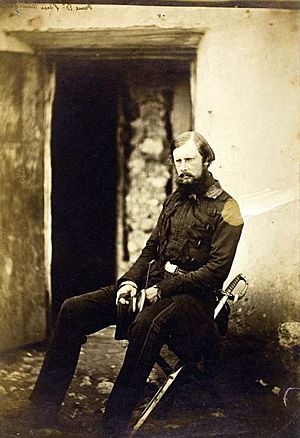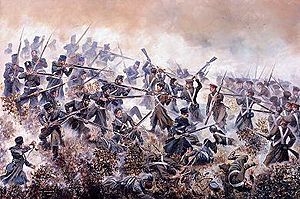Prince Edward of Saxe-Weimar facts for kids
Quick facts for kids Prince Edward |
|||||
|---|---|---|---|---|---|
| Prince of Saxe-Weimar-Eisenach Duke of Saxony |
|||||

Prince Edward in 1855
|
|||||
| Born | 11 October 1823 Bushy House, London |
||||
| Died | 16 November 1902 (aged 79) Portland Place, London |
||||
| Burial | Chichester Cathedral | ||||
| Spouse |
Lady Augusta Katherine Gordon-Lennox
(m. 1851) |
||||
|
|||||
| House | Saxe-Weimar-Eisenach | ||||
| Father | Prince Bernhard of Saxe-Weimar-Eisenach | ||||
| Mother | Princess Ida of Saxe-Meiningen | ||||
| Religion | Lutheranism | ||||
| Occupation | Military | ||||
Prince William Augustus Edward of Saxe-Weimar-Eisenach (born October 11, 1823 – died November 16, 1902) was a British military officer. He came from a German royal family. Edward had a long career in the British Army, especially with the Grenadier Guards. He rose through the ranks to become a very senior officer. Eventually, he was promoted to field marshal in 1897.
Contents
Prince Edward's Military Career
Early Life and Joining the Army
Edward was born on October 11, 1823. His parents were Prince Bernhard and Princess Ida. He was born at Bushy House in London. This house belonged to his aunt, Adelaide. She was married to the future King William IV of the United Kingdom.
Edward became a British subject. His military career started on June 1, 1841. He had trained at the Royal Military College, Sandhurst. He joined the 67th (South Hampshire) Regiment of Foot as an ensign. An ensign was a junior officer rank.
Rising Through the Ranks
Edward quickly moved to the Grenadier Guards. On June 8, 1841, he became an ensign in the Guards. He was also made a lieutenant in the Army. By May 19, 1846, he was a lieutenant in his regiment. He also became a captain in the Army. In November 1850, he became an adjutant for his battalion. An adjutant helps with administrative tasks.
Service in the Crimean War
On June 20, 1854, Edward was promoted to brevet major. This was a temporary higher rank. He served in the Crimean War. This war took place from 1853 to 1856. Edward fought in several important battles.
Key Battles and Promotions
- He fought at the Battle of Alma in September 1854.
- He was at the Siege of Sevastopol in October 1854. He was slightly injured there.
- He also fought at the Battle of Balaclava in October 1854.
- He was part of the Battle of Inkerman in November 1854.
For his brave service, he was promoted. On December 12, 1854, he became a brevet lieutenant-colonel. This was for his "distinguished Service in the Field."
Later Career and Retirement
On October 5, 1855, Edward became an aide-de-camp to Queen Victoria. He also became a colonel in the Grenadier Guards. In 1866, he and his wife were given the title of Royal Highness.
Senior Commands
Edward continued to advance in his career.
- On March 6, 1868, he became a major-general.
- In 1870, he was appointed Major General commanding the Brigade of Guards. He also commanded the Home District.
- On July 6, 1877, he was promoted to lieutenant general.
- In October 1878, he became General Officer Commanding the Southern District.
- On November 4, 1879, he became a full general.
- In October 1885, he was made Commander-in-Chief, Ireland. He also joined the Privy Council of Ireland.
- He retired from the Army in October 1890.
Life After the Army
After retiring, Edward stayed busy. He was a commissioner for the Lloyd's Patriotic Fund. This fund helped soldiers and sailors. He also became a colonel for two regiments. These were the Royal Lincolnshire Regiment and the 1st Regiment of Life Guards.
On June 22, 1897, he was promoted to field marshal. This is the highest rank in the British Army. Some people noted that he achieved this rank without major military victories.
Prince Edward had a summer home in North Berwick. In October 1902, he received the Freedom of the Royal burgh of North Berwick. This was a special honor from the town. Just a week before, he had hosted King Edward VII there.
Edward passed away on November 16, 1902. He died at Portland Place in London. He was buried at Chichester Cathedral. His wife's family crypt was there.
Prince Edward's Family Life
On November 27, 1851, Edward married Lady Augusta Katherine Gordon-Lennox. She was the daughter of the 5th Duke of Richmond. Their marriage was considered "morganatic." This meant that Augusta's children would not inherit Edward's royal titles.
The day before their wedding, Augusta was made Countess of Dornburg. She was usually known by this title. Later, she was referred to as "Princess Edward of Saxe-Weimar." Prince Edward and Princess Augusta did not have any children.
Honours and Awards
Prince Edward received many awards and honors during his life. These came from different countries.
 Saxe-Weimar-Eisenach: Grand Cross of the White Falcon, November 20, 1839
Saxe-Weimar-Eisenach: Grand Cross of the White Falcon, November 20, 1839

 Ernestine duchies: Grand Cross of the Saxe-Ernestine House Order, November 1842
Ernestine duchies: Grand Cross of the Saxe-Ernestine House Order, November 1842 Kingdom of Hanover: Grand Cross of the Royal Guelphic Order, 1849
Kingdom of Hanover: Grand Cross of the Royal Guelphic Order, 1849 United Kingdom:
United Kingdom:
- Crimea Medal, 1854
- Companion of the Bath (military), January 24, 1857; Knight Commander, May 24, 1881; Knight Grand Cross, June 21, 1887
- Knight of St. Patrick, December 18, 1890
- Knight Grand Cross of the Royal Victorian Order, March 8, 1901
 French Empire: Knight of the Legion of Honour, August 2, 1856
French Empire: Knight of the Legion of Honour, August 2, 1856 Ottoman Empire:
Ottoman Empire:
- Crimean War Medal, 1856
- Order of the Medjidie, 3rd Class, March 2, 1858
 Netherlands:
Netherlands:
- Grand Cross of the Military William Order, April 7, 1858
- Grand Cross of the Netherlands Lion
 Mecklenburg: Grand Cross of the Wendish Crown, with Crown in Ore, May 19, 1867
Mecklenburg: Grand Cross of the Wendish Crown, with Crown in Ore, May 19, 1867 Kingdom of Prussia: Grand Cross of the Red Eagle, September 8, 1874
Kingdom of Prussia: Grand Cross of the Red Eagle, September 8, 1874 Württemberg: Grand Cross of the Württemberg Crown, 1876
Württemberg: Grand Cross of the Württemberg Crown, 1876 Grand Duchy of Hesse: Grand Cross of the Ludwig Order, July 9, 1881
Grand Duchy of Hesse: Grand Cross of the Ludwig Order, July 9, 1881




